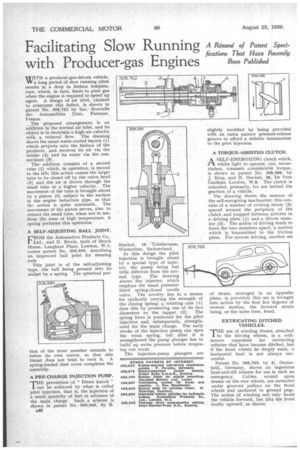Facilitating Slow Running A Resume of Patent Speci
Page 52

If you've noticed an error in this article please click here to report it so we can fix it.
with Producer-gas Engines
MITH a producer-gas-driven vehicle, W a long period of slow running often results in a drop in firebox temperature, which, in turn, leads to poor gas when the engine is required to speed up again. A design of air inlet, claimed to overcome this defect, is shown in patent No. 508,762 by Soc. Nouvelle des Automobiles Unic, Puteaux, France.
The proposed arrangement is an addition to the normal air inlet, and its object is to maintain a high air-velocity with a reduced flow. The drawing shows the usual water-cooled tuyere (1) which projects into the firebox of the producer, and receives its air via the intake (4) and its water via the connections (3).
The addition consists of a second tube (2) which, in operation, is moved to the left; this action causes the larger tube to be closed off by the valve head (5) and the air is drawn through the small tube at a higher velocity. The movement of the tube is brought about by a piston (6) subject to the suction in the engine induction pipe, so that din action is quite automatic. The movement of the piston serves, also, to retract the small tube, when not in use, from the zone of high temperature. A spring performs this operation.
A SELF-ADJUSTING BALL JOINT. L-ROM the Automotive Products Co.,
Ltd., and D. Brock, both of Brock House, Longhorn Place, London, W.1, comes patent No. 508,890, describing an improved ball joint for steering rods This joint is of the self4djusting type, the ball being pressed into its socket by a spring. The spherical por tion of the inner member extends to below its own centre, so •that side thrust does not tend to rock it. A spring-loaded dust cover completes the assembly.
A PRE-CHARGE INJECTION PUMP.
T"prevention of "Diesel knock" can be achieved by what is called pilot injection, that is, the injection of a small quantity of fuel in advance of the main charge. Such a scheme is shown in patent No. 508,945, by B.
A4'2
Bischof, 16 Tobelstrasse, Winterthur, Switzerland.
In this design the pilot injection is brought about by a special type of injector, the pump being but little different from the normal type. The drawing shows the injector, which employs the usual pressurelifted spring-closed needle valve. The novelty lies in a means for cyclically varying the strength of the closing spring; a rotating cam (1) does this by presenting one of its two diameters to the tappet (2). The spring force is weakened for the pilot injection and, subsequently, strengthened for the main charge. The early stroke of the injection pump can open the weak spring, but after it is strengthened the pump plunger has to build up extra pressure before reopening can occur.
The injection-pump plungers are slightly modified by being provided with an extra narrow pressure-release groove to afford a definite termination to the pilot injection.
A TORQUE-ASSISTED CLUTCH.
ASELF-ENERGIZING clutch which, whilst light to operate, can, nevertheless, transmit considerable torque, is shown in patent No. 508,088; by J. Kiep, and H. Sinclair, 38, De Vere Gardens, London, W.8. The clutch is intended, primarily, for use behind the gearbox of a vehicle.
The drawing shows the essence of the self-energizing mechanism; this consists of a number of rocking struts (3) spaced around the periphery of the clutch and trapped between notches in a driving plate (1) and a driven member. (2). The action of driving tends to force the two members apart, a motion which is transmitted to the friction plate. For reverse driving, another set of struts, arranged in an opposite plane, is provided; this set is brought into action by the first few degrees of reverse motion, the forward struts being, at the same time, freed.
EXTRICATING DITCHED VEHICLES.
THE use of winding drums, attached to the driving wheels, is a wellknown expedient for extracting vehicles that have become ditched, but if the front wheels be deeply sunk, a horizontal haul is not always successful.
Patent No. 508,763, by K. Oesterheld, Germany, shows an ingenious haul-and-lift scheme for use in such an emergency. Cables, wound upon drums on the rear wheels, are extended under grooved pulleys on the front wheels and anchored to ground pegs. The action of winding not only hauls the vehicle forward, but lifts the front bodily upward, as shown.












































































